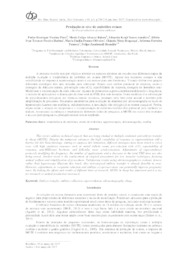Produção in vivo de embriões ovinos.
Produção in vivo de embriões ovinos.
Authorship: PINTO, P. H. N.; BALARO, M. F. A.; ARASHIRO, E. K. N.; BATISTA, R. I. T. P.; OLIVEIRA, M. E. F.; BRAGANÇA, G. M.; FONSECA, J. F. da; BRANDÃO, F. Z.
Summary: Resumo: A presente revisão tem por objetivo abordar os aspectos técnicos em estudos nas diferentes etapas da múltipla ovulação e transferência de embriões em ovinos (MOTE). Apesar dos inúmeros avanços a alta variabilidade de resposta à superovulação ainda é um entrave para esta biotécnica. Visando driblar este gargalo diferentes estratégias têm sido testadas para selecionar fêmeas com melhor potencial de resposta, como a contagem de folículos antrais, pré-seleção com eCG, repetibilidade de resposta, dosagem do hormônio anti-Mülleriano e sincronização da onda folicular. Ajustes de protocolos superovulatórios modificando a frequência, o número de aplicações e a diminuição da dose total de FSH, têm sido testados. Outra tendência é a substituição de procedimentos cirúrgicos por técnicas menos invasivas, prezando pelo bem estar animal e também pela simplificação de processos. Resultados satisfatórios para avaliação de doadoras por ultrassonografia ao invés de laparoscopia ilustram esta tendência. Adicionalmente, a inovulação não cirúrgica já se mostra exequível. Porém, etapas como a seleção de receptoras e a criopreservação de embriões também têm potencial para melhorar os índices. Associando os esforços e resultados de diferentes linhas de pesquisas, a MOTE em ovinos têm evoluído e seu uso para pesquisa ou produção animal tem-se ampliado. [In vivo production of ovine embryos]. Abstract; This review address technical aspects that are being studied in multiple ovulation and embryo transfer in sheep (MOTE). Despite the numerous advances the high variability of response to superovulation still a barrier for this biotechnology. Aiming to suppress this limitation, different strategies have been tested to select ewes with high ovulatory response such as antral follicle count, pre-selection with eCG, repeatability of response, anti-Müllerian hormone, and follicular wave synchronization. Adjustments of superovulatory protocols modifying the frequency, the number of applications and a decrease in the total FSH dose are also being tested. Another trend is the replacement of surgical procedures for less invasive techniques, focusing animal welfare and simplification of procedures. Satisfactory results using ultrasonography to evaluate donors, rather than laparoscopy illustrate this trend. Also non-surgical embryo transfer is already feasible in ewes. However, adjustments in recipients selection and embryo cryopreservation can potentially improve pregnancy rates. By linking the efforts and results of different lines of research, MOTE in sheep has improved and it is use for research or animal production increased.
Publication year: 2017
Types of publication: Journal article
Unit: Embrapa Goats & Sheep
Observation
Some of Embrapa's publications are published as ePub files. To read them, use or download one of the following free software options to your computer or mobile device. Android: Google Play Books; IOS: iBooks; Windows and Linux: Calibre.
Access other publications
Access the Agricultural Research Database (BDPA) to consult Embrapa's full library collection and records.
Visit Embrapa Bookstore to purchase books and other publications sold by Embrapa.

